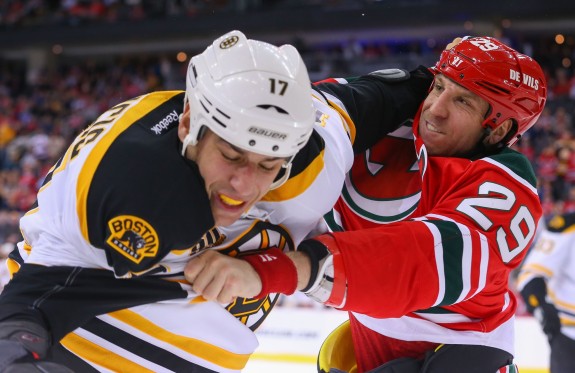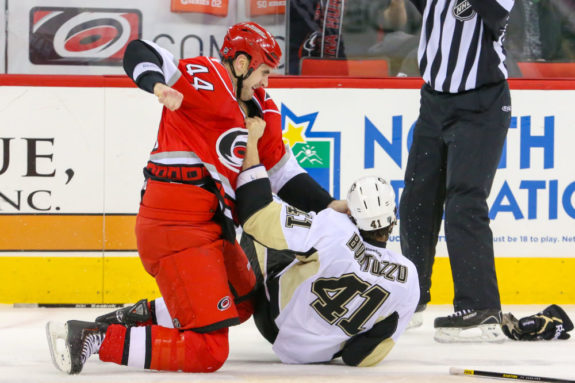This post is part of our series – Hockey 101
Ahh fighting. To the uninitiated and rookie fans of the NHL, fighting is the most exciting part of hockey. However, the effects of fighting are becoming more and more clear and public opinion has turned against the physical combat on ice. But there is more to understand about the last gladiators of sports than just pummeling another player.
How Exactly is Fighting Legal?
Before anything else, let’s cover the basic penalty that follows a fight. Each combatant serves a five minute major. This does not put either team down a man and keeps it at 5-on-5. This does not include instigator penalties, which will be discussed later.
Popularized by videos online and Hollywood movies (see: Goon), fighting has been a major part of the game of hockey for a very long time. Unlike in other sports, fighting is heavily regulated and sanctioned. When the benches clear in baseball or basketball, referees scramble to try and calm tensions. However, NHL and other hockey referees are trained in the physical altercations that overwhelm other sports officials.

While it may look chaotic, starting a fight is actually somewhat of an art. Hockey players are constantly talking to each other. Whether it is to pump up teammates or pester opponents, there is chatter on the ice. A fight starts in one of two ways, it is either planned or heat of the moment. To plan a fight, two players will usually “chirp” at each other and eventually, if things get heated the usual “You wanna go?” comes up. The gloves of both players drop as soon as play starts. Play is stopped and all other players clear the area while the refs watch closely. As soon as one participant goes down the zebras move in and separate them.
Heat of the moment fights take place when play is already going on and players drop their gloves. Whether it’s a heavy hit on the team’s superstar or just two speeding trains coming together, these fights are usually behind the play. Again, refs stop play and wait until the bout comes to an end.
New Penalties Associated With Fighting

In an effort to reduce the number of fights in the game, the NHL has recently introduced the Instigator and Aggressor penalties. The Aggressor penalty is assessed to a fighter that hits or attempts to hit a player who is unwilling or defenseless. For instance, if a player starts a fight and the other does not want to participate but the initial fighter continues and hits the latter, he is deemed an aggressor. A player is also an aggressor if he clearly has won a fight (the other player is down and defenseless) yet he is still throwing punches. Aggressors are also assessed a game misconduct on top of their five minute major. Suspensions and fines can be added at the league’s discretion.
The Instigator penalty is different. Both players are willing participants but one player sets himself apart by clearly starting the fight. This is where communication between the two fighters is important. A player can be given an Instigator penalty if he drops his gloves first, travels a great distance to start the fight, if the fight is retaliation from previous altercations with his opponent, or other criteria the refs can use. If deemed the Instigator, a player is assessed a two minute minor (that will put his team down a man) and also a ten minute misconduct penalty in addition to the five minute major.

Further Discipline
Multiple Aggressor and Instigator penalties in a single game or season can lead to supplemental discipline from the league. Stéphane Quintal, the face of Player Safety, will be releasing a video about the player if either of those penalties occur too much. The third Aggressor penalty in a season is immediately suspended for the next two games. This increases by two games for every subsequent Aggressor in the regular season. This process is the same for the Instigator penalty.